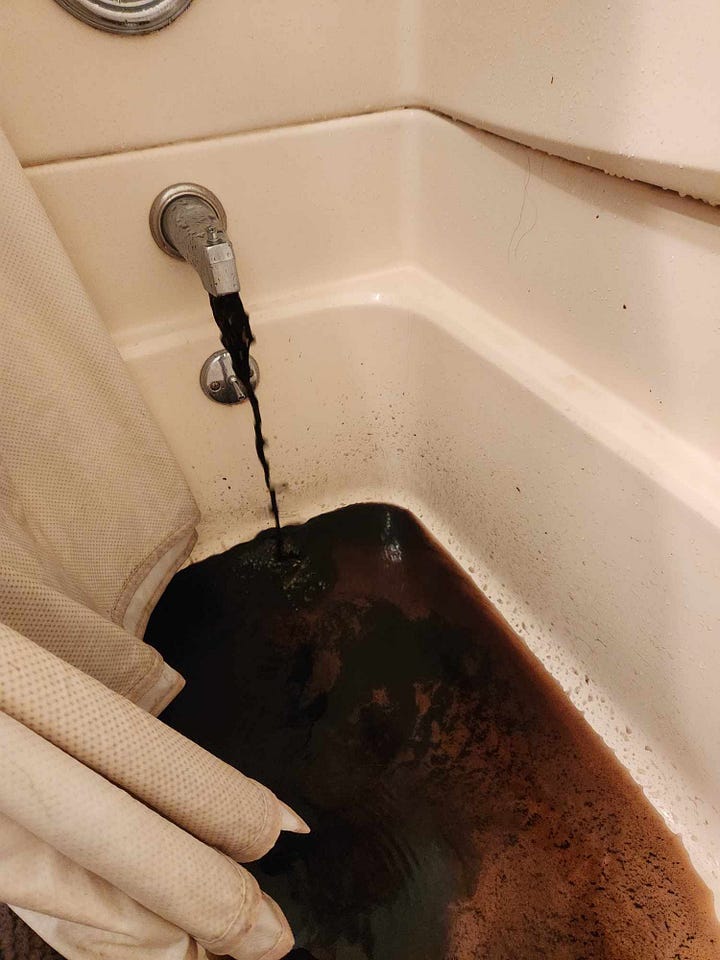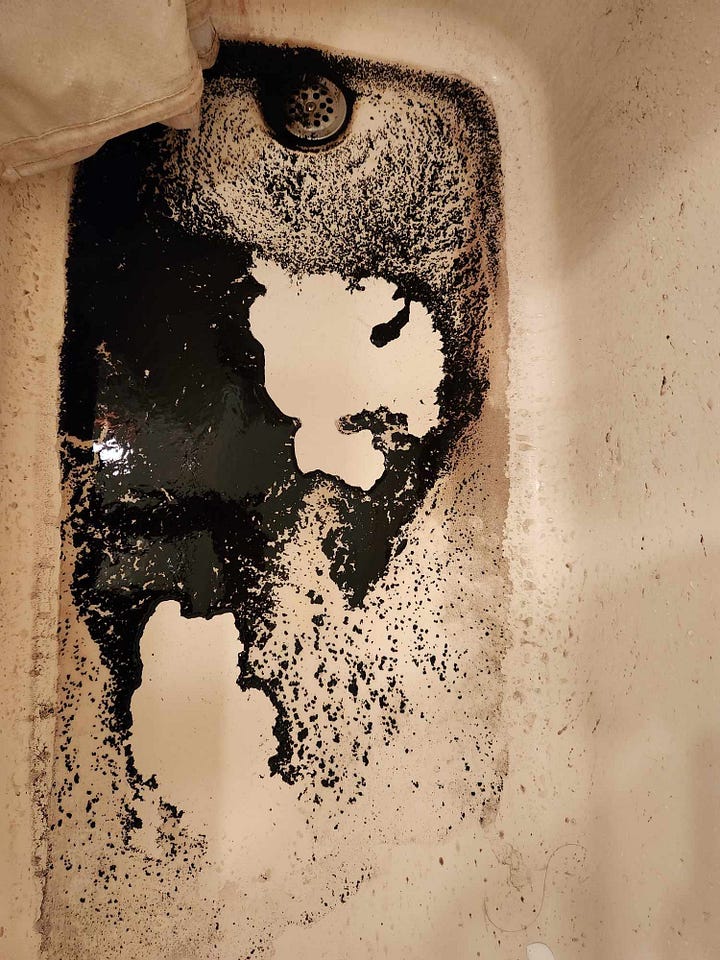Mud-Colored Water? Are You Kidding Me?
An Action Guide for Residents in Beaver County, PA, & Beyond


Black water flowing from the taps. Washing machines dying premature deaths. No one should have to drink or interact with water that looks this bad.
Sorry to bring you more scary water photos, but it’s important to know what communities are dealing with across the country. These images reflect what’s coming out of the taps in Beaver County, Pa., not too far from Pittsburgh and about 30 minutes from East Palestine, Ohio.
In late August, the Pennsylvania Department of Environmental Protection (DEP) ordered corrective action from the Industry Borough Municipal Authority following an inspection. The agency issued a field order to the authority, requiring it to put out a “Do Not Use” notice.
The notice comes after samples showed levels of manganese that exceed the U.S. EPA’s health advisory limit.
It’s important to note that no one in the area should boil this water, as boiling it will concentrate the manganese, not remove it.
One community source in Industry told me, “The water looks like mud. It’s disgusting.”
She also shared that the community of about 1,800 residents is comprised of many elderly people, who are very concerned about their health. So far, the borough is not providing bottled water.
The advisory will remain in effect until the authority shows manganese levels are below the limit, and the DEP issues a “Problem Corrected” notification to consumers.
The area’s water source comes from ground water, and specifically two wells located within the Industry Borough jurisdictional limits.
Do Not Use Water Advisory
Local health authorities issue a do not use water advisory when your community’s water is, or could be, contaminated with germs, harmful chemicals, toxins, or radioactive materials.
Under this advisory any contact, even with the skin, lungs, or eyes, can be dangerous.
Do not drink or use tap water from the impacted system for any purpose as long as the advisory is in effect, including for bathing.
Ongoing Water Issues
A copy of the 2024 Annual Drinking Water Quality Report from the municipality does not show elevated levels of manganese or iron. In fact, it says, “We are pleased to report that our drinking water meets federal and state requirements.”
But the DEP previously entered a consent order and agreement with the authority, requiring it to install a new treatment plant to address prior manganese concerns.
In March 2023, residents attended an Industry Borough Municipal Authority meeting to voice their frustrations with ongoing water quality issues, bringing up elevated manganese levels and low water pressure problems at the public session.
At one point the meeting reportedly got heated with police being called to remove a resident after he brought up additional comments outside of his 5-minute time frame.
Residents called for action to fix these problems and voiced their frustrations in waiting for a solution.
Some community members began to brush up on EPA regulations and Right-to-Know requests. Many started buying bottled water while paying for tap water they can’t use. This isn’t just inconvenient. It’s wrong; it’s expensive; and it needs to stop.
It’s clear to me that some kind of band-aid approach may have been applied, and the root of the problem was not fully addressed.
Manganese & Your Health
Let’s talk manganese for a minute. This mineral occurs naturally in rocks and soil, and it’s often found in combination with other minerals, like iron.
Trace amounts of the mineral can be good for health. However, too much manganese can contribute to health issues such as muscle pain, nerve damage and fatigue. A 2020 study discussed that overexposure to the mineral impacts both motor function and higher-order cognitive functions.
Research has found higher concentrations of manganese in drinking water are associated with adverse health outcomes, especially for vulnerable and susceptible subpopulations like children (or the elderly).
That same study reveals how manganese is commonly used as a fungicide in agriculture, and as a key component in steel production, which results in agricultural run-off and industrial contamination of drinking water sources.
Signs of manganese in drinking water include:
An orangey-brown tint
Orange or brown staining on surfaces that come into contact with water
Metallic taste or smell
Dark black or brown stains on laundry
How The EPA Regulates Manganese
Drinking water concentrations of manganese are not federally regulated.
In other words, there’s no maximum contamination level (MCL) for manganese, but the EPA does note that in concentrations higher than 0.05 ppm manganese may become noticeable by impairing color, odor, or taste to the water.
(According to the field order, samples in Industry yielded a result of .43 ppm)
The EPA has set a lifetime health advisory (LHA) for manganese at 0.3 ppm, and short-term exposure to manganese, even at low levels, is considered a health risk to infants below 12 months of age.
MCLs are established to protect the public against consumption of drinking water contaminants that present a risk to human health. An MCL is the maximum allowable amount of a contaminant in drinking water which is delivered to the consumer and is an enforceable law.
Manganese falls into what the EPA calls “National Secondary Drinking Water Standards.” These standards are non-mandatory water quality standards set for 15 contaminants. EPA does not enforce these “secondary maximum contaminant levels” (SMCLs). They are established as guidelines to assist public water systems in managing their drinking water for aesthetic considerations, such as taste, color, and odor.
In other words, SMCLs are not federally enforceable.
The 2024 Annual Quality Report from Industry Borough states that, “water treatment is limited to chlorination.”
In working with dozens of communities across the country that the use of chloramines (adding ammonia and chlorine to treat the water) can be corrosive and cause pipes in the system to leach out lead, manganese, iron, and more. One avenue I would encourage residents to explore is whether the water treatment system is adding ammonia to the water.
A closer look at the Industry Borough Municipal Authority’s water quality report on EWG.org/Tapwater shows chemicals like chloroform, bromodichloromethane, dibromochloromethane, and bromoform, within legal limits, but also indicative of adding ammonia to the water, a process also called chloramination.
Next Steps…
For community members living in Industry or nearby supporters, here’s some ideas for moving forward:
Document Everything
Take photos and videos of that disgusting water every single time it comes out brown, cloudy, or filled with sediment. Date and time stamp everything. Keep a daily log. That washing machine that died? Document it. Clothes ruined? Keep them and photograph them. Medical issues that started or worsened? Write it down with dates. Keep building a case, and every single piece matters.
Consider Independent Water Tests
Don’t wait for someone else to tell you your water is fine. Contact an independent, certified lab and get your water tested for contaminants, heavy metals, bacteria—the works. Yes, it costs money. But you know what costs more? Health problems down the road that nobody can prove came from your water because you didn’t test it. Keep every test result. Get more info here.
File Right-to-Know Requests
While some community members may have started this process, everyone can participate. File requests with your municipal water authority for:
All water quality test results from the past three years
Maintenance records for the water system
Any violations or warnings from regulatory agencies
Emergency response plans
Infrastructure repair records
Pennsylvania’s Right-to-Know Law is on your side. They have to respond within five business days. If they don’t, follow up in writing. Be polite but relentless.
Report to the Pennsylvania DEP
File a complaint with the Pennsylvania Department of Environmental Protection. Don’t assume someone else is doing it. Call their Southwest Regional Office at 412-442-4000 or file online. Be specific: dates, times, what the water looked like, what it smelled like, any health impacts. Reference other complaints from your neighbors. Make them pay attention.
Additional Resources
Band Together
You’ve already started a Facebook page. Now take it further. Form an official residents’ association. There’s power in numbers, and lawyers, politicians, and media pay attention to organized groups, not individual complaints. Meet regularly. Compare notes. Pool resources for testing and legal help.
Demand a Town Hall Meeting
Your elected officials work for you. Demand they hold a public meeting about the water crisis. Show up in force. Bring your evidence. Ask hard questions:
What is causing the contamination?
What’s being done to fix it?
When will it be fixed?
Who’s paying for damages to residents’ property?
What’s the long-term plan to prevent this?
Don’t accept vague answers or promises to “look into it.”
Protect Your Health Right Now
While you’re fighting this fight, protect yourself and your family:
Use bottled water for drinking, cooking, baby formula, and brushing teeth
If you can afford it, install point-of-use filters (reverse osmosis is best)
Keep vulnerable family members (babies, elderly, immune-compromised) away from tap water entirely
Watch for skin irritation from bathing and showering or other health issues
Don’t Give Up
I know you’re exhausted. I know this is consuming your life when you should be enjoying your home, your family, your morning coffee by the river. But here’s the truth: nobody is going to fix this for you unless you force them to. Not the water company, not the politicians, not the regulators. They will drag their feet, minimize the problem, and hope you get tired and go away.
Don’t go away.
You deserve clean water. Your children deserve clean water. Your elderly parents deserve clean water. It’s not a luxury; it’s a basic human right. Every dollar you spend on bottled water, every ruined appliance, every moment of worry about your family’s health—that’s on someone else’s negligence, and they owe you.
Keep fighting. Keep documenting. Keep demanding answers. And remember the only difference between a contaminated water system that gets fixed and one that doesn’t is residents who refuse to shut up about it.
You’ve got this, Industry.
Your water. Your health. Your fight. Don’t back down.
Further Education
Here’s a 15-minute training from the National Groundwater Association on “Removing Iron and Manganese to Improve Water Quality in Residential Wells.”
Nearby & Notable
In April, the Pennsylvania governor’s office announced the investment of $242.8 million for 32 drinking water and wastewater projects across 23 counties through the Pennsylvania Infrastructure Investment Authority (PENNVEST).
The projects include replacing lead service lines, rehabilitating aging systems, upgrading service capabilities, extending service to more communities, and reducing environmental contaminants through compliance with current regulatory levels.
In Beaver County, the Borough of Baden and Borough of Monaca received money to make improvements. How can Industry join that list and get more funding?
Read more about the Shell Plant in Beaver County.
Beaver County group calls on DEP for more timely reports on Shell ethane cracker air pollution
Beaver County’s Economy Flounders while Neighboring Counties Prosper
Black Water: How Industry Fights Controls of Little-Known Drinking Water Contaminant
What was your initial reaction when you saw those photos? Have resources or advice to share? Keep the conversation going down below!



This Action Guide is a fantastic template for our water issues in Trenton, NJ. Can't restack quick enough!
You cannot live without clean water that is life’s number one need to survive with oxygen ! And we humans are destroying both! Why????